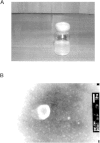Urea immunoliposome inhibits human vascular endothelial cell proliferation for hemangioma treatment
- PMID: 24266957
- PMCID: PMC4222881
- DOI: 10.1186/1477-7819-11-300
Urea immunoliposome inhibits human vascular endothelial cell proliferation for hemangioma treatment
Abstract
Background: Urea injection has been used in hemangioma treatment as sclerotherapy. It shrinks vascular endothelial cells and induces degeneration, necrosis, and fibrosis. However, this treatment still has disadvantages, such as lacking targeting and difficulty in controlling the urea dosage. Thus, we designed a urea immunoliposome to improve the efficiency of treatment.
Methods: The urea liposome was prepared by reverse phase evaporation. Furthermore, the urea immunoliposome was generated by coupling the urea liposome with a vascular endothelial growth factor receptor (VEGFR) monoclonal antibody using the glutaraldehyde cross-linking method. The influence of the urea immunoliposome on cultured human hemangioma vascular endothelial cells was observed preliminarily.
Results: Urea immunoliposomes showed typical liposome morphology under a transmission electron microscope, with an encapsulation percentage of 54.4% and a coupling rate of 36.84% for anti-VEGFR. Treatment with the urea immunoliposome significantly inhibited the proliferation of hemangioma vascular endothelial cells (HVECs) in a time- and dose-dependent manner.
Conclusions: The urea immunoliposome that we developed distinctly and persistently inhibited the proliferation of HVECs and is expected to be used in clinical hemangioma treatment.
Figures



Similar articles
-
Significant inhibition of infantile hemangioma growth by sustained delivery of urea from liposomes-in-microspheres.Oncol Rep. 2018 Jan;39(1):109-118. doi: 10.3892/or.2017.6103. Epub 2017 Nov 20. Oncol Rep. 2018. PMID: 29192323 Free PMC article.
-
Delivery of sodium morrhuate to hemangioma endothelial cells using immunoliposomes conjugated with anti-VEGFR2/KDR antibody.Int J Nanomedicine. 2017 Sep 19;12:6963-6972. doi: 10.2147/IJN.S144056. eCollection 2017. Int J Nanomedicine. 2017. PMID: 29033564 Free PMC article.
-
Anti-HER2 immunoliposomes: enhanced efficacy attributable to targeted delivery.Clin Cancer Res. 2002 Apr;8(4):1172-81. Clin Cancer Res. 2002. PMID: 11948130
-
Future directions of liposome- and immunoliposome-based cancer therapeutics.Semin Oncol. 2004 Dec;31(6 Suppl 13):196-205. doi: 10.1053/j.seminoncol.2004.08.009. Semin Oncol. 2004. PMID: 15717745 Review.
-
Immunoliposomes: a promising approach to targeting cancer therapy.BioDrugs. 2001;15(4):215-24. doi: 10.2165/00063030-200115040-00002. BioDrugs. 2001. PMID: 11437687 Review.
Cited by
-
The baffling human body and the boundless nanomaterial boon-a trap for cancer crab.J Clin Diagn Res. 2014 Jul;8(7):ZE09-12. doi: 10.7860/JCDR/2014/9245.4584. Epub 2014 Jul 20. J Clin Diagn Res. 2014. PMID: 25177660 Free PMC article. Review.
-
Nanotechnology in Infantile Hemangioma Management.J Pediatr Pharmacol Ther. 2025 Feb;30(1):27-46. doi: 10.5863/1551-6776-30.1.27. Epub 2025 Feb 10. J Pediatr Pharmacol Ther. 2025. PMID: 39935564 Free PMC article.
-
Progress in the treatment of infantile hemangioma.Ann Transl Med. 2019 Nov;7(22):692. doi: 10.21037/atm.2019.10.47. Ann Transl Med. 2019. PMID: 31930093 Free PMC article. Review.
-
Significant inhibition of infantile hemangioma growth by sustained delivery of urea from liposomes-in-microspheres.Oncol Rep. 2018 Jan;39(1):109-118. doi: 10.3892/or.2017.6103. Epub 2017 Nov 20. Oncol Rep. 2018. PMID: 29192323 Free PMC article.
-
Delivery of sodium morrhuate to hemangioma endothelial cells using immunoliposomes conjugated with anti-VEGFR2/KDR antibody.Int J Nanomedicine. 2017 Sep 19;12:6963-6972. doi: 10.2147/IJN.S144056. eCollection 2017. Int J Nanomedicine. 2017. PMID: 29033564 Free PMC article.
References
-
- Miller T, Frieden IJ. Hemangiomas: new insights and classification. Pediatr Ann. 2005;34:179–187. - PubMed
-
- Li GC, Gu JZ. Infantile Hemangioma. 1. Xian: Shaanxi Science and Technology Press; 1991.
-
- Wang XZ, Li GC, Gu JZ. Seclective arterial catheterization and urea injection treatment of huge cavernous hemangiomas. Zhonghua Wai Ke Za Zhi. 1985;23:367–368. - PubMed
-
- Qiao JB, Li J, Ma YC, Guo XN, Zhu XS, Dong CX. Combined treatment with urea injection and surgical procedure for the scrotal vein malformation in teenagers. Zhonghua Zheng Xing Wai Ke Za Zhi. 2012;28:256–260. - PubMed
MeSH terms
Substances
LinkOut - more resources
Full Text Sources
Other Literature Sources
Medical

